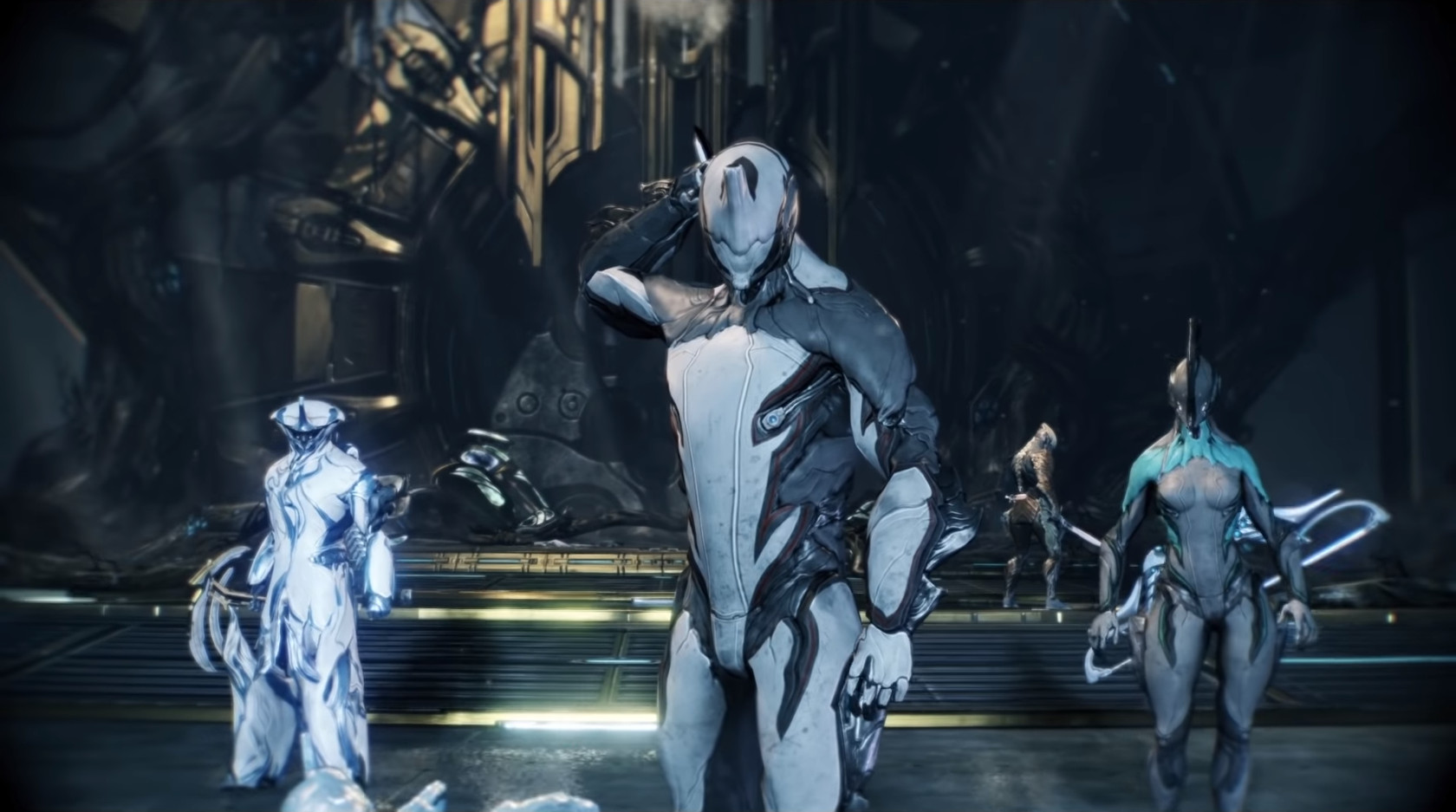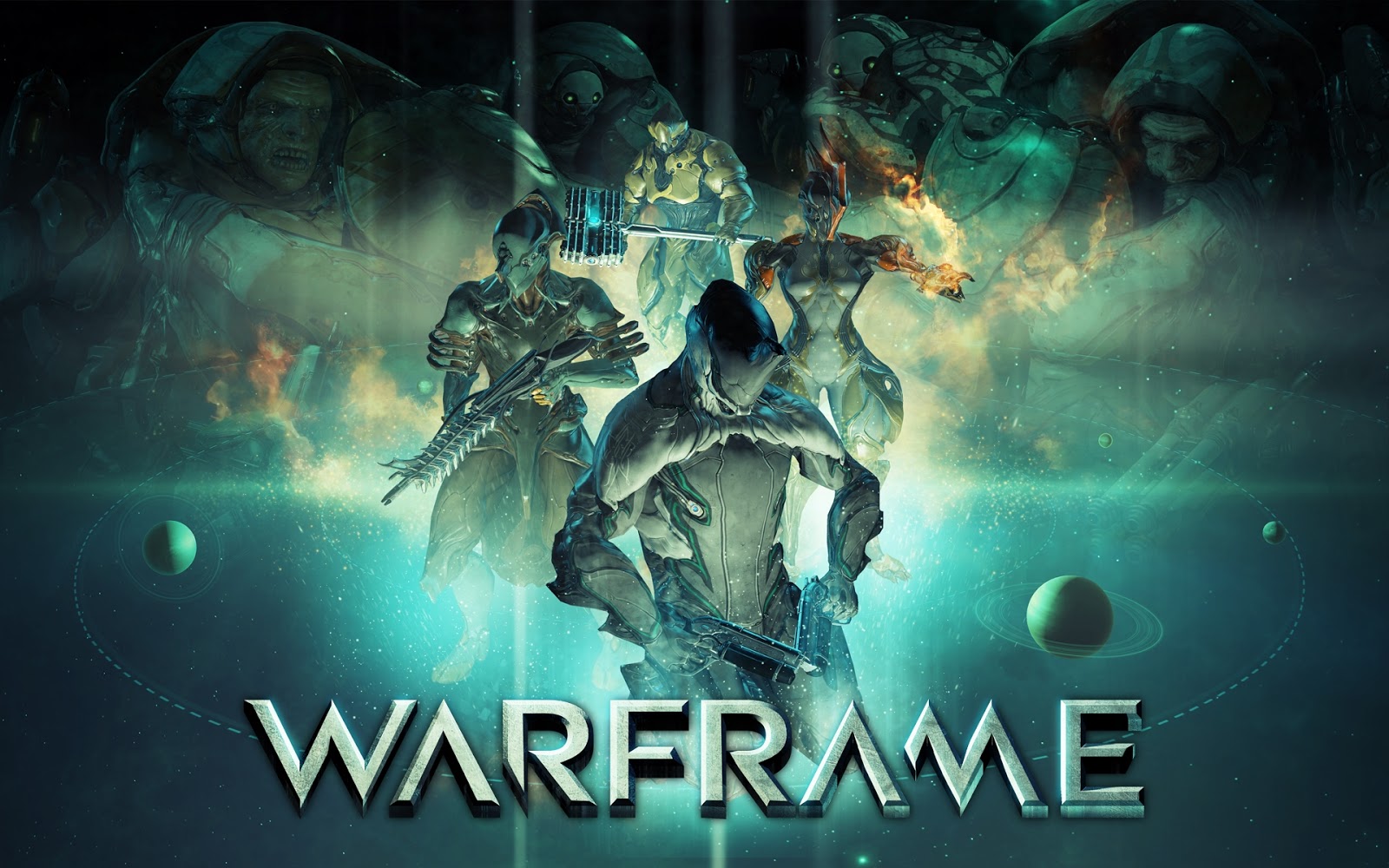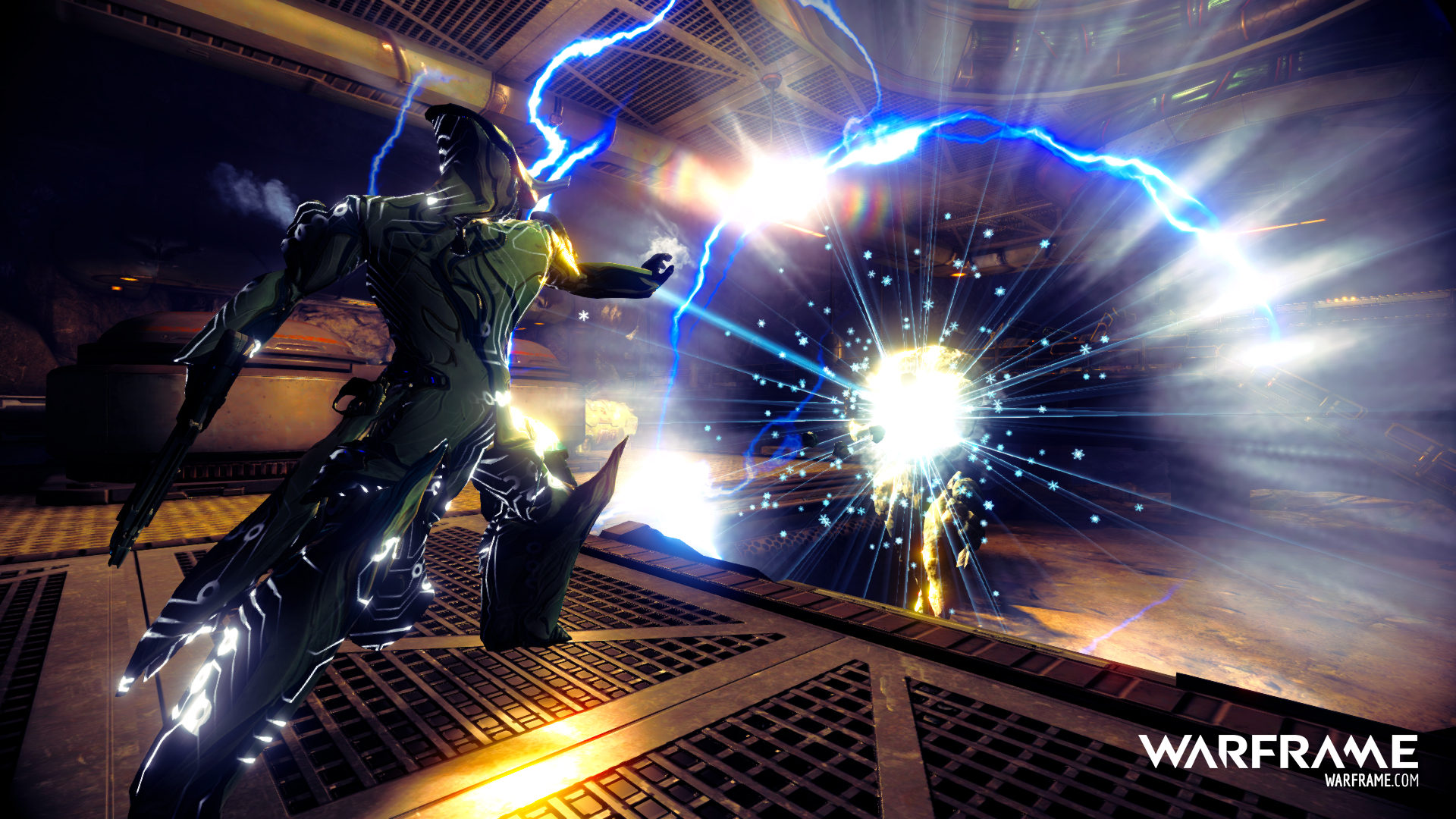Warframe – Review
The first time I played Warframe, it was, quite frankly, terrible. The gameplay was boring, there wasn’t even a semblance of a story, the visual design was strange, the tutorials were nonexistent, the UI was among the worst I’d ever seen, and it was pay to win rather than free to play. All in all, I played about an hour and a half before I grew disgusted with it and uninstalled it from my machine.
Between then and the latest update, however, the game seems to have caught on to the concept of ‘fun.’ The gameplay is much more varied and enjoyable, the UI has been cleaned up, tutorials have been implemented (to a point), and it’s actually possible to get new weapons, classes, and equipment without dumping real money into the game.
In Warframe you play as a space ninja. Why? Because space ninjas. That’s all the reason you’re given, and all the reason you need, frankly. You fight against an assortment of enemies, including the Grineer, a bunch steroid dropping jocks who all seem to have forgotten leg day, the Corpus, who’re evil capitalist pigs, and the Infested, who are pretty much the Flood with a different skin.
Starting Out

The game starts out with you choosing one of three available Warframes to play, the Volt, the Mag, and the Excalibur. Honestly, I don’t know why they do this, as it locks you into one playstyle before you even know what’s going on. This means that if you choose wrong, you have to live with it until you can farm something better, start an entirely new profile, or shuck out some money to buy a new (hopefully better) Warframe.
I’ll give you one guess which one the developers are hoping for.
Anyway, once you’ve decided on which Warframe you want, you’re treated to a short exposition filled cinematic where you’re introduced to generic enemy faction #1 the Grineer, then dumped right into combat. You can’t die at this point, but the transition is still a little jarring. On the bright side, for the first few wave of enemies you have unlimited Energy, so you can spam as many of your Warframe’s abilities as you want, giving you a bit of a feel for what you’ve chosen. I picked the Mag, which specializes in engaging multiple low level enemies at once. The Excalibur, on the other hand, likes to jump into the middle of combat and lay about with his melee weapon, and the Volt is a hybrid direct damage dealer and utility caster.
After you’ve killed the enemies in the area and you’ve explored a bit, you’re given a choice between 3 melee weapons, which are laid out all nice and pretty on the table for you. While you can come back if you decide you don’t like one, you can’t take all three with you, which is disappointing. Your options are the Bo staff, some pointy metal boxing gloves, and a sword. At the time the only apparent difference between the three seemed to be the attack speed, so I went with the sword. After you’ve killed a few enemies with your melee attacks, you get to make the same decision with secondary weapons (throwing daggers, submachine gun, and semi-auto pistol), and finally primary weapons (bow, assault rifle, and shotgun). Personally, I went with the semi auto pistol and the assault rifle for my secondary and primary, but that turned out to be a mistake. The pistol, even modded, does virtually no damage, and neither does the assault rifle. The bow and the throwing daggers, on the other hand, are both silent and do excellent damage for starter weapons.
After that, there are a bunch of primer missions to introduce you to each of the different mission types. These can range from simply killing everything on the map to extracting a captive from the prison, and culminates in an assassination mission, which turns out to be a fancy name for a boss fight.
After that, though, the game pretty much lets you figure out things on your own. There’s no real tutorial on installing mods, crafting new items, improving mods, or even interplanetary navigation. It me quite a while to figure out how to unlock new missions, and quite a bit longer to find out how to get to new planets. Granted, once I figured it out (or was told by my friends who also play the game) it was so simple that I had to give myself a few good kicks in the pants, but a little bit of instruction on the developer’s part would have saved me that embarrassment.
What’s worse is that the more complicated things, like resource extraction, joining or creating clans, filling the codex, or what Dark Sectors are and what happens when you access them are all left completely untouched by the game developers with the exception of a few pages of text that you can scroll through. While these text tutorials are very appealing visually, they explain very little, meaning you pretty much either have to look things up on a Wiki, figure them out for yourself, or get a friend who knows what’s going on to help you.
Gameplay
Warframe plays a lot like the Mass Effect 3 multiplayer. You can team up with up to three other players, which can either be friends that you’ve invited to play with you or other space ninjas who’re lurking around, to play through a variety of missions. Each mission starts out with you and your squad slipping in behind enemy lines undetected. If you want, you can try to stealth through the level, silently killing the enemies that you encounter. This means staying out of direct line of sight of your opponents. This might sound simple, but the only ‘stealth mechanic’ that the game boasts is crouching. You can’t hide under objects, deliberately take cover, slink across doorways, or pretend that you’re a ceiling panel the way River Tam or Matt Fisher do. Additionally, the game’s pathing is inconsistent and, at the time of writing, kind of messed up. Enemies will consistently try to walk up walls, get caught on mundane objects, or take unpredictable routes. Combine this with how many enemies there are on a level, how the enemy will instantly recognize you as hostile, and how the instant one so much as catches a glimpse of you, the whole room instantly knows where you are, it makes trying to sneak your way through a level extremely difficult, if not downright impossible. If you’re really unlucky, one of them will make it to a control panel, which will alert the whole level to your presence. While you can disarm the alarms without too much trouble, most of the time it isn’t really worth it.
On the plus side, everyone except you and your buddies seem to be fanatics of cremation, even going so far as to cary immolation charges on their persons so that as soon as their heart stops beating they burst into flames, so you never have to worry about hiding bodies.
Still, the game’s stealth mechanics are pretty subpar and for the most part you’re not equipped to silently kill from a distance, so most of your missions will go loud pretty quickly. Besides, there’s no reward for doing a mission without being detected, and the running and gunning in this game is a lot more fun than the half assed stealth system. Not only that, but if you’re in public matchmaking, chances are all of the people you play with will just run in guns blazing.
Once bullets have started flying things are pretty straightforward. You have a primary weapon, a secondary weapon, and a melee weapon, along with an assortment of supernatural space ninja powers. Your primary weapon, can be anything from a standard rifle, to a shotgun, to a sniper rifle. There are a couple of bows thrown in there as well, which act like sniper rifles with a charge up time and slow projectiles. The secondary weapons are pistols, submachine guns, and sawed off shotguns, with some throwing stars and daggers for good measure, and the available melee weapons range from swords to axes to pole arms to whips.
All things considered, this is a pretty impressive arsenal, but no space ninja game would be complete without space ninja powers, and each warframe comes with its own assortment of them, ranging from fire to ice to antimatter, all coming in the flavors of offensive, defensive, and utility. Each Warframe has 4 of these powers, and they’re all built around a theme. For example, the Mag Warframe uses magnetic powers, the Volt uses electric powers, and the Loki is useless turns invisible. These powers are probably the single greatest factor in your playstyle as they pretty much dictate how you interact with your enemies, and what your role in the squad is.
Each of your space ninja powers takes energy to execute, ranging between 25 and 100 depending on how powerful they are, limiting how often you can execute them, but energy is fairly common throughout the level, as most enemies and containers have at least a chance of dropping the precious blue orbs. Still, it can be fairly panic inducing to see a wave of enemies walk around a corner when you’re out of energy.
At the start of each level each player will receive a different bonus objective which will award the player with a hefty amount of bonus XP. This objective can be anything from killing 30 enemies with your primary weapon to getting 5 kills while sliding. These objectives are given out regardless of weather or not you can actually complete them, like getting 10 kills on unaware enemies on a survival mission, which has no stealth option.
All in all, the combat is pretty smooth, if a bit repetitive. You kill waves and waves and waves of enemies because you’re a space ninja. That seems to be this game’s rationale for nearly everything that happens; why are you killing those guys? Because you’re a space ninja. How are you killing them? Well, you’re a space ninja, that’s how. Where did you get those awesome powers? Space ninja. Anyway, the biggest flaw the combat has is that, other than a tiny bar in the top right corner of your screen, there is no visual indication of what your shield integrity is at, or how close you are to dying. I’ve gotten myself killed on multiple occasions simply because I dove headlong into combat when I should have been taking cover and waiting for my shields to regen.
Mission Types
There are a surprising number of mission types, but they all basically revolve around killing everyone on the map, retrieving an object, depositing an object, defending a point, surviving for as long as possible, capturing a target, or killing a boss. Honestly, though, the mission objectives just turn into white noise after one or two playthroughs, and it mainly turns into just killing and farming. The only real exceptions to this are the boss fights, which the developers did a pretty good job at making unique, the survival missions, which make you activate life support systems that are teleported in at regular intervals, and the capture missions, in which you have to hunt down a high level enemy, incapacitate them, then suck out their soul. Regretfully, no bonus points are awarded if you make a Mortal Kombat reference while doing so.

Maps
On the other hand, while the game only has a handful of maps which it recycles throughout the game, regardless of the mission type. While these maps are downright huge at times, it doesn’t take very long before you know them all a little too well. Not only that, but the maps and the mission types don’t always seem to match up. It’s particularly funny to play a survival mission, which requires you to activate supplementary life support systems, in the middle of a flourishing jungle, or on an open mountainside. On top of that, the Venusian maps seem to all be completely snow covered, which is strange to say the least. Last I checked, Venus was the hottest planet in our solar system, clocking in at a nice toasty 864º F. That’s warm enough to melt lead, which means that snow probably wouldn’t stick around too long.
Enemies
You’ll encounter 3 different factions throughout the game; the Grineer, the Corpus, and the Infested. All the factions are pretty generic, though, and none of the enemies that you face will be really interesting to fight or require different tactics to kill. The Grineer have a lot of tough units, the Corpus have a lot of shielded units, and the Infested have a lot of melee units. That’s pretty much the extent of the variety of the game, which is extremely disappointing since killing them is pretty much the only thing you do. Literally the only difference between the Grineer and the Corpus is the unit skins and the speed of the projectiles that come at you. These guys shoot bullets and look like one of Dr. Frankenstein’s experiments gone wrong, and these guys shoot blue energy bolts and look like Pyramid Head cosplayers. They both have basic soldiers that shoot at you, slightly tougher soldiers that shoot at you, units that give cover or shields to other enemies, guys that run up and try and hit you, and high damage dealers. That’s it.
The Infested are a little different, but not by much, and they don’t show up very often. Their main theme seems to be an emphasis on things that want to eat your face, almost to the exclusion of ranged combat entirely, and they seem to be much more numerous and weaker, but that just means that you can mow through each individual unit easier.
Of course the reason for killing any given faction is just as flimsy and generic as their unit compositions. The Grineer, for instance, you kill because they’re ugly evil. That’s more than enough justification, right? The Corpus, on the other hand, are greedy capitalist pigs who sell weapons to the Grineer. As for the Infested, well, they’re just downright gross, which is a way better reason to go around exterminating them than the other two have.
Gameplay Overall
Between the repetitive missions, the small map pool, and the boring enemies, the game can get pretty dull. It’s only going to be a couple of hours before you’ve played through the majority of the combinations between the three, and after that the game turns into a grind for materials and blueprints to build better equipment and mods so you can grind for materials and blueprints more effectively.
In fact, the main staying power this game has is getting new Warframes, because then you can grind for materials in blueprints in a slightly different way. It’s like doing another playthrough of Mass Effect with a different class, except there’s none of that troublesome story or decision making, just endless killing.
Story
The story is virtually nonexistent, which is disappointing. What little lore there is has virtually no bearing on the story, and ends up being more trivia than anything. Not only that, but the lore is neither interesting nor impactful. Not only that, but it manages to be both shallow and convoluted at the same time.
Characters
The game only has a handful of characters that interact with the player in any meaningful way, and all of them are annoying. There’s Lotus, who’s the omnipresent authority figure, Ordis, the AI of your ship who’s totally NOT damaged or psychotic in any way, and the various bosses, who pretty much just throw generic insults at you as you beat them to death with their own limbs.
Lotus is annoying because she’s the cliche emotionless chick that seems to be required in each and every game nowadays. She tells you what to do, which wouldn’t be so bad if she had more than 10 lines of dialogue. This wouldn’t be so grating if she had some quirky trait, like speaking exclusively in haiku, but as it stands she’s just the generic boss figure who just happens to have a female voice.
Ordis is nearly as bad. His dialogue pool is just as small, and his voice is extremely annoying. His only saving grace is that he’ll switch from annoying subservient butler to psychotic ball of rage and back again all in one sentence. Still, this doesn’t happen often enough to be a truly redeeming quality, and his voice is probably the most irritating voice I’ve heard in a video game so far.
The various bosses are even worse, spouting things like, “I see you!” and “Trivial threat detected.” This happens no matter how many times you’ve killed this particular boss, or how thoroughly you’re currently thrashing him.
The developers seriously need to fire whoever wrote the dialogue for this game, and probably find some new voice actors while they’re at it.
Progression
To say that Warframe’s progression goes at a snail’s pace would be an insult to snails. Unless you’re willing to dump money into the game, upgrades to weapons and Warframes are few and far between.
To be fair, improving the equipment that you already own is relatively easy; you just install some mods which boost various statistics like damage or shield capacity. Mods themselves aren’t too hard to come by. Some are rarer than others, but you can expect to find at least one mod per mission, and some missions can drop as many as 15. This means that you have good odds for either finding new mods or getting fodder for improving the mods that you currently have.
It’s getting new equipment that sucks so much.
At the outset, the progression system doesn’t look too terrible. You can either buy weapons and Warframes outright using real money, or you can buy a blueprint for in game money. If you’re lucky, you might even find a blueprint when you kill a boss. Blueprints allow you to build the piece of equipment, be it weapon or Warframe, yourself, assuming that you have the requisite resources and credits to do so. Once you’ve got all the ingredients, your shipboard 3D printer will start working on a brand spanking new weapon or Warframe for you to enjoy. It generally takes at least 12 hours to finish an item, but you can work on as many items as you want, which is makes the huge time requirement less arduous. Between the actual build time and how long it takes to farm all the materials that you need, it probably takes between 15 and 20 hours total time to put together a new piece of equipment.
The problem comes, then, with how the market will sell you blueprints that need resources that you have no hope of farming. For example, when I decided I needed a replacement for my starting weapon, I decided to buy the blueprint for the Latron, a semi automatic rifle with good damage. Only once I’d bought it did I find out that I couldn’t farm the majority of the components the blueprint needed until I’d gotten to Saturn, which I wasn’t even close to unlocking. Likewise, I bought the blueprints for the Nova Warframe, only to find that the necessary components could only be found on Europa, which was even farther along. This meant that to actually use the blueprints that I’d purchased I would either have to wait until I’d finally gotten to where I could farm the various components necessary, or pay real money to buy the resources I needed.
I have very little patience for this form of intellectual dishonesty, especially when it would be so easy to restrict access to those blueprints until you’d reached a point in the game where you could conceivably use them, or even just explicitly state that this particular item needs components that can only be found on Pluto right in the description.
This is just an easy way for the developers to trick a little extra money out of players, which is pretty disgusting when you think about it.
On top of that, the prices for items using real money are pretty absurd. The cheapest items, excluding resources, are a whopping $5. This isn’t as bad as some games (I’m looking at you, Mechwarrior: Online), but it’s by no means good.
Visual Design
The visual design of the game is an interesting matter to say the least. On the one hand, the Warframes are some of the most visually interesting and varied player characters that I’ve seen in a game. All of the different Warframes have a unique profile, which makes them easily identifiable even at a glance. Additionally, all the designs are consistent with the whole space ninja battle suit theme, in addition to giving you a slight hint as to what their abilities are. The Zephyr, for example, has a very angular and streamlined look, where the Nekros looks more than happy to eat your soul. Still, whatever Warframe you end up going with, the grand majority of the time you’re going to be staring at their finely sculpted backside, thanks to the third person perspective, so it might not matter a whole lot.
On the other hand, the enemies that you go up against couldn’t be more laughable or idiotic. For example, the Grineer, who are by far the most common enemy you face, all look like Starcraft marines who forgot leg day. The Corpus are a little bit better, but not by much. Nearly all the Corpus’ units look like they’ve started up a cult that worships polygons as divine, or they all decided to go as Pyramid Head to Space Comi-Con. To spice it up on the Corpus side, though, there are a few completely robotic units running or flying around, which consist of a pair of legs and a pair of wings, respectively. Better, but still far from the epitome of visual design.
In fact, the only enemies that the developers seem to have done a good job on are the Infested, and those things are downright disgusting. My first look at the things literally sent a shiver down my spine, which is pretty darned impressive.

Conclusion
All in all, the game plays like a Japanese flavored Mass Effect 3 knock off made people who have only a vague idea of what Japanese culture is like. This is so apparent that it’s even obvious to someone like me, who has only the vaguest idea of the Japanese and their history. Additionally, where ME3 had a great variety of interesting weapons, and enemies, Warframe’s are almost the epitome of generic.
Still, the game has redeeming qualities. The individual Warframes are well designed, both visually and game play wise. I would say that Warframe might even surpass ME3 in this area, as it has a greater variety of unique and interesting classes than ME3 did, and while the stealth system is almost criminally underdeveloped, it has a stealth system, where ME3 is exclusively run and gun. If fleshed out, it would make an excellent contribution to how the game plays. The ninja aspects of the game, like the wall running and the emphasis on melee combat are interesting as well, giving a bit of variety to the typical 3rd person shooter.
All in all, this isn’t a bad game. It’s certainly not a great game, but it’s free to play, which means that the only thing you can lose by playing it is time.




